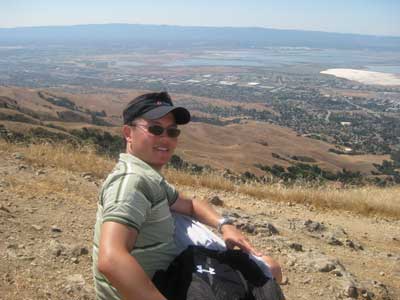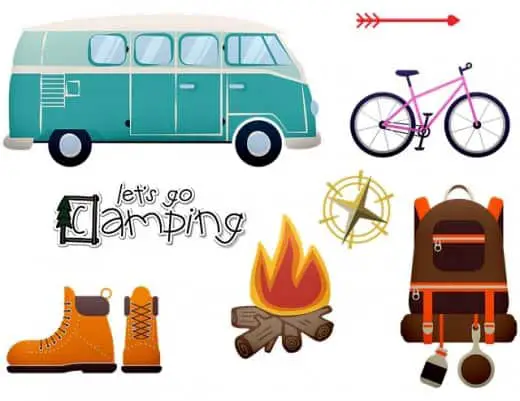
Camping doesn’t have to be an uncomfortable experience. You can set up your camping trip to be very comfortable and even fancy if you do it right.
Here are some tips to help you make your camping trip more comfortable and enjoyable:
- Get the right tent
- Bring the right sleeping arrangements
- Bring candles and incense
- Bring a hammock
- Bring camping chairs
- Bring an inflatable couch
- Bring a power source
- Bring solar-powered lights
- Bring a camp stove
- Bring a cooler
- Bring a French Press
- Know your environment
- Use the hot stone trick before bed
- Bring sleeping aids
Get the Right Tent
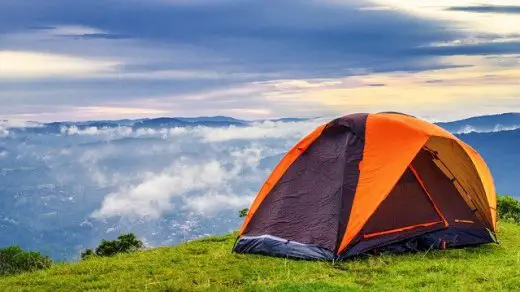
Tent Size
If your main concern is to make yourself comfortable, a bigger tent is probably what you’re looking for. Smaller tents have the advantages that they are lighter and easier to pack, but they sacrifice roominess for these advantages. Having a tent that you can stand and walk around in will make your space feel much more inviting and fun to be in.
Two-season, three-season, four-season, and five-season tents
There are many different tents available to you. They come in all different shapes and sizes and are designed to meet a wide variety of different needs. You have two, three, four, and five season tents to choose between.
- Two-season tents are light and should be for warm-weather camping only. They are designed to be cool, even in hot weather.
- Three-season tents are your best all-around tents. They are designed for spring, summer, and fall. With some enhancements, you can use them in the winter too.
- Four and five-season tents are very warm tents that you will want to use if you are camping in very cold conditions.
Pop Up Tents
The advantage of these tents is that they are very easy to set up. Often, it is possible to have your tent up in as little as two minutes. This gives you more time to relax or have fun and less frustration from setting up a tent that requires a degree in rocket science to figure out.
Teepees
Camping in a teepee will make your trip a little out of the ordinary. Teepees offer a lot of space as they are tall, wide, and open. You can even have a fire in your teepee if it is set up correctly.
Glamping Tents
Glamping tents are designed to be extra spacious and cozy. They make you feel like you are in an actual room.
Usually, glamping tents are made out of canvas rather than plastic. The canvas gives the space inside more of a natural and fancy ambiance than you get out of the plastic materials that normal tents are made of.
Set Up Your Bed and Bedding
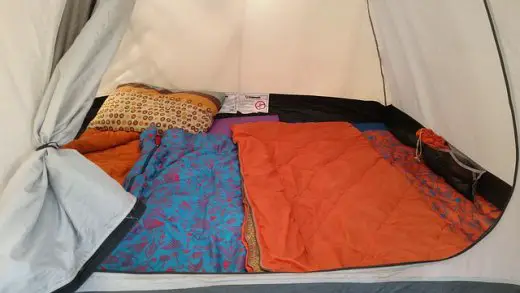
There are many options when it comes to what to sleep on and how to stay warm at night. Some may be fine with just a sleeping bag, while others will want a mattress with plenty of blankets and pillows to keep you comfortable, warm, and set the mood.
Mattresses
For ultimate camping comfort, bring a portable mattress. This might mean an inflatable mattress, or you could bring a foam mattress with a camping cot.
Inflatable mattresses are great. Because they are inflatable, they pack down nicely and are easy to set up. They make thick double air mattresses that are very comfortable. These mattresses will make you feel like you are sleeping on a real bed, especially when you add comforter, blankets, and pillows into the mix.
Camping cots are also very comfortable and can make you feel like you’re doing a little more than just camping. The biggest downside to cots is that they are bulky and take up a lot of room.
Sleeping Pads
Sleeping pads are for your more minimal campers. They are great because they are often very compact but allow for a very comfortable night’s sleep.
Sleeping pads will also keep you warmer during the night by insulating you from the cold ground. There are three different types of sleeping pads; air pads, self-inflating pads, and closed-cell foam pads.
Air pads are the most lightweight and packable of the three. You simply inflate them with air, and they are ready to be slept on. Not all people are comfortable sleeping on these pads, though.
Self-inflating pads use a combination of foam and air to make the most comfortable type of sleeping pad. The foam in the pads is very compressible and can be rolled up into a small bundle.
When you are ready to use the pad, you just take the cap off. They are designed to suck in air and inflate themselves as the foam expands.
Once they are full of air, you seal them off again so that the air does not escape, and the foam stays less compacted when you sleep on it. Self-inflating pads are less compact than air pads, but most people find them more comfortable.
Closed-cell foam pads have no inflatable feature making them the bulkiest and hardest to pack type of pad. They are nice and comfortable to make up for it and are often cheaper than the other two types of sleeping pads.
Closed-cell foam pads also offer the best insulation from the ground to keep you warm at night. Commonly, people will use a closed-cell foam pad and then put a self-inflating pad or an air pad on top to reach maximum comfort and insulation from the ground.
Sleeping Bags or Bedding
You’re going to need something to keep you warm and comfy at need besides just your mattress or sleeping pad. A sleeping bag is a classic way to keep yourself warm when you are camping. Sleeping bags are designed to be packable, and different ones are made for different conditions.
You may want something a little more comfortable and cozy than a sleeping bag if you are trying to snazz up your camping trip.
If you are setting up a full bed to sleep on, it will be a lot nicer to bring sheets, blankets, pillows, and a comforter to sleep with. This will give you the feeling that you’re camping like a king or queen!
Set the Mood With Candles and Incense
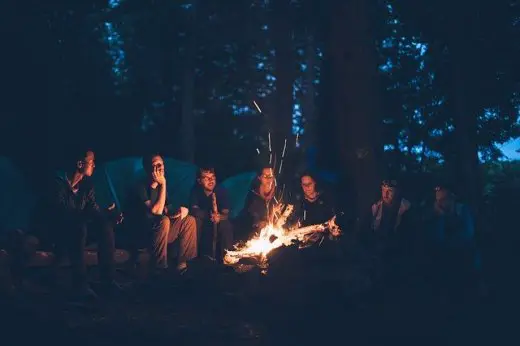
If you want to add a little extra character to your campsite, you can create some ambiance with candles or incense. Set candles up around your tent to create a warm and romantic vibe. You can burn incense too to create a nice smell.
Be careful when bringing candles inside your tent, though. You don’t want to light the tent on fire while you are inside!
Bring a Hammock for Maximum Relaxation
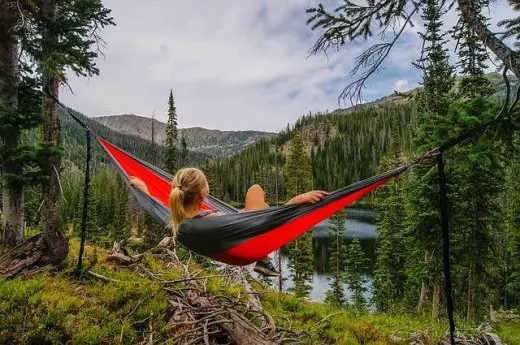
Fancy napping like a sloth during the day or kicking back and reading a great book? Bring a hammock with you!
A hammock will give you a great spot to relax during the day, and some people even like to sleep in them at night. Who needs a tent when you’ve got a hammock?
Bring Comfortable Camping Chairs
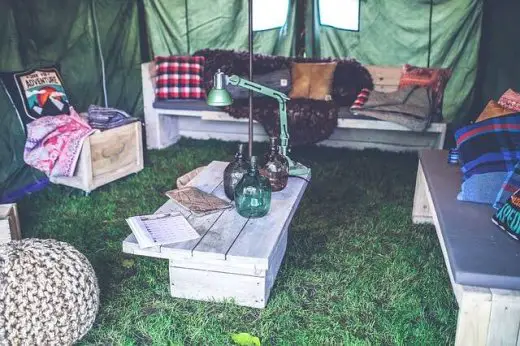
Don’t settle for uncomfortable wooden benches or the hard rocky ground to sit on. Bring comfortable camping chairs with you.
The standard folding camping chair is easy to set up and folds so that you can pack it in your car without taking up too much space. You may want to opt for an even more comfortable folding chair. Some are padded and even have reclining features.
Bring an Inflatable Couch
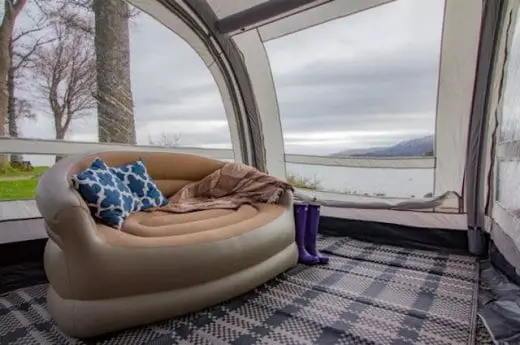
Inflatable couches are a novel approach to the camping bedding situation. Many couches also double as air mattresses, so you can fit multiple people on one.
The possibilities are endless. You might even be able to float down the river while drinking a cold one! Note: don’t do this.
Bring a Power Source
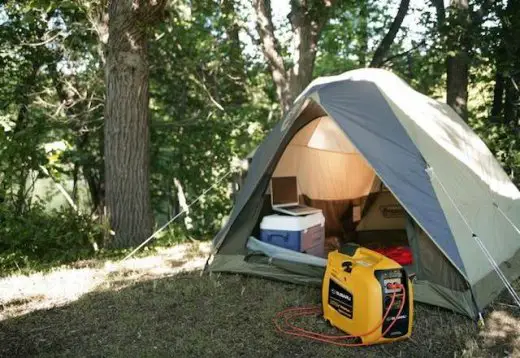
Bringing a power source can make your camping trip a lot more comfortable. Many people think that camping should be an escape from the modern amenities, but that doesn’t mean you can’t enjoy camping and also keep your appliances charged at the same time.
There are several options to pick between to power your campsite; car inverters, a battery bank, solar panels, or a generator.
The easiest way to keep charged is to buy an inverter for your car. The inverter will plug into your car’s 12v plugin and convert the power to a 120v plugin that you can use. The downside of this method is that you may not always be camping close to your car. In that case, you will need a portable power supply to bring with you.
You can bring a battery bank with you to charge your electronics at your campsite. They make many different battery banks, some large and some small, with a wide variety of features. Make sure your battery bank is charged before you take it camping with you, and you’re good to go.
The biggest downside with the battery bank is that your battery life is limited and you may run out of power. To make up for this downside, you can add solar panels to your battery bank so you can charge it during the day. This is a great option because it allows you to generate and store power wherever you go, and it’s environmentally friendly.
Your last option for campsite electricity is to bring a generator. Generators burn fuel to create electricity.
I personally recommend using a generator as your last resort because there are some big downsides.
Generators are very noisy when they are running, so bringing one to your campsite might mess up the feeling of solitude that you get out in nature. Not to mention that it will totally freak out the surrounding wildlife.
Generators are also heavy and require you to haul gas. They also put out fumes that might not be pleasant. One of the reasons for camping is to get away from all the polluted air in the city.
Light Up Your Walkway With Solar Lights
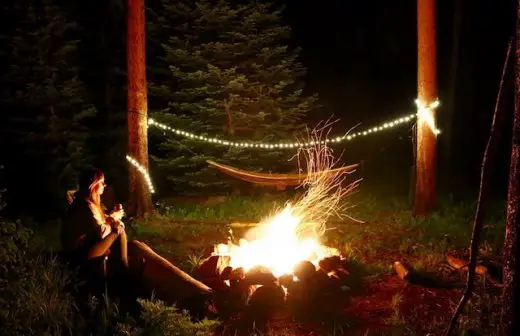
Solar lights are an easy way to light up your campsite at night and give it some pizazz. Most dollar stores carry these things for a buck each. You can’t go wrong with that. Set them up all around your campsite to light your way and create a nice vibe.
Make Your Meals Special
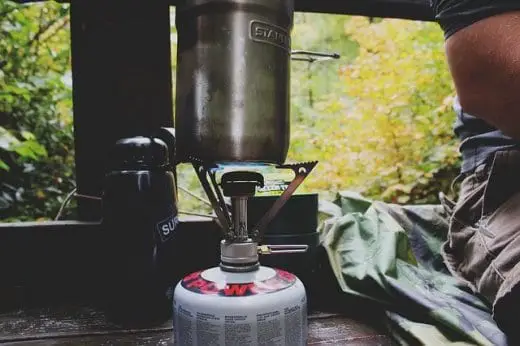
Just because you’re camping doesn’t mean your only options for mealtime are hotdogs and granola. You can cook decadent meals over the fire pit if you plan ahead and put some effort into the preparation.
Think ahead before you go camping and plan out some different meals that you want to eat. There’s no reason your camping diet needs to be bland or boring.
Bring a Camp Stove
A camp stove will be a great addition to your campsite. It will allow you to easily cook a wide variety of different foods while you are camping. You can make pasta or stir-fries very easily. In the morning, you can whip up some pancakes or French toast.
Bring a Quality Cooler
You’re probably going to want to keep some of your food cold when you’re out camping. You don’t want your food to spoil now, do you?
To ensure you have cold food, make sure you get the right cooler for the job. Any cooler will work, but some work much better than others.
It’s going to be a hassle to have to restock ice every couple of days. Therefore, try to get a high-quality cooler that will make your ice last for up to a week. These coolers are a little more pricey, but not having to fetch ice is well worth it if you’re going to be camping a lot.
Get a Waterproof Ice Bag
When the ice in your cooler melts, it can get your food wet and soggy. You don’t have to put up with that anymore.
To help with this, check out this watertight ice bag. You put your ice inside the bag, and it keeps it from creating a mess in your cooler.
Not only does it keep your food dry, but it also turns your ice into drinking water. No more having to drain your cooler when the ice melts. You can just drink it now instead.
Bring a French Press
You’re probably going to want your morning coffee while you’re camping.
Fortunately, you don’t have to settle for low-quality instant coffee. Bring a French press with and you will be able to brew your favorite brand of coffee right there at your campsite.
Just boil some water over your campfire or on your camp stove, and you’re ready to enjoy your delicious morning beverage.
Know Your Environment and the Local Hazards
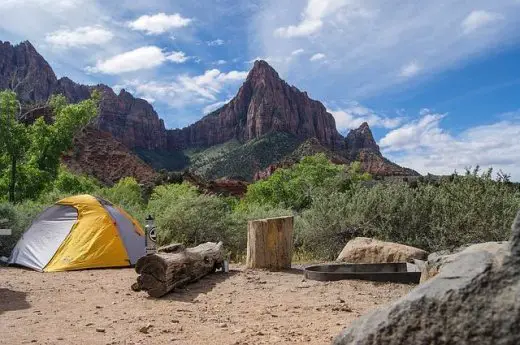
Your camping trip is meant to be a fun and exciting adventure for you and your friends or loved ones.
You know the old saying, “It’s all fun and games until someone gets hurt.” Camping isn’t something you should be scared of. Generally, it is a pretty safe activity. You should, however, educate yourself on the different harmful plants and pests in the area that might cause you trouble.
Poison Ivy, Poison Oak, Poison Sumac
Don’t be the guy that accidentally wiped with poison oak when he forgot to bring toilet paper along to take care of his morning duties. Poison oak, poison ivy, and poison sumac are all potentially harmful plants that carry a nasty oil called urushiol.
Contact with these plants can cause a nasty rash that will make you miserable for several weeks and can even take up to a month to go away. Urushiol is no joke; it can make your life descend into a living nightmare for what seems like an unbearably long time.
Severe exposure to any of these plants can land you in the hospital and even cause death in some cases. This is unlikely, though, because it requires full-body exposure to a lot of urushiol. Most cases only result in a localized rash that itches and burns, making you very uncomfortable.
Urushiol is not only nasty to the skin, but it is also very resilient and sticks to things. Urushiol can stick to tools and clothes for up to two years. It is possible to get it on your hands and then rub it all over your body by accident.
Often, symptoms of poison oak will not show up for two to three days, so it can be easy not to realize you have it and then spread it all over the place.
If you suspect that you may have been exposed to any of these plants, wash the affected area immediately with lukewarm or cold water and soap. If soap is not available, rub the affected area with dirt to help wipe off as much of the urushiol as possible.
All three of these plants are fairly easy to identify if you know what you are looking for. Check out this guide to learn how to identify them.
Bears, Racoons, Wild Dogs, and Other Pests
All of these wild mammals can be really annoying to deal with and can even pose significant dangers to you. These animals, even bears, are not something to be too worried about.
Most of the time, they run away if they see you. Even a bear doesn’t want to mess with humans. Your food is what they are really after, and they will go to very annoying lengths to get to it. Animals will tear through your bags, tents, or anything else that you have left your food inside.
There are a few ways that you can avoid attracting animals, and they all include locking up your food. Leaving your food in your car or camper is the easiest way to do this. Even a bear won’t be able to get into your car.
Another solution is to bring a bear-proof cooler or a food lockbox with you. These food storage devices are designed to keep your food safe from wildlife.
Lastly, you can stay at a campsite that comes with a food storage box built into the facilities.
Ticks
This is probably the scariest pest on the list. A tick bite can cause Lyme disease along with many other diseases that have lifelong consequences.
Lyme disease has no known cure and can have debilitating symptoms for those that are infected. These symptoms include; rash, joint pain, flu-like symptoms, fatigue, malaise, and mental fogginess. For some, the fatigue caused by Lyme disease is so bad that they are unable to continue in their chosen line of work.
Fortunately, there is a lot you can do to defend yourself from tick bites and prevent disease.
The first preventative measure is to do daily tick checks. Most tick-carried diseases need at least eight hours to transmit from the tick to your body.
Eight hours is the minimum; most of the time, it takes more like 24 hours to contract the disease. This means that a tick bite will not hurt you so long as you remove the tick in time.
If you are in a tick-infested area, make sure to do a thorough full-body tick check every night. They like to go for hairy areas such as the head, armpits, and groin, so check those areas extra well. You will need a friend or a family member to check your head for you.
There are some areas that have tick epidemics: Massachusetts and other New England states, for example.
Areas with tick epidemics have a large number of ticks out in the wild, with 50% or more of these ticks carrying Lyme disease.
This article is owned by Recapture Nature and was first published on February 14, 2020
If you are camping in one of these places, you will probably want some extra defense. Products that contain DEET or permethrin will stop ticks from climbing up onto your body. Permethrin is the most effective one. You can treat both your body and your clothes to keep ticks away.
Use The Hot Water Bottle Trick
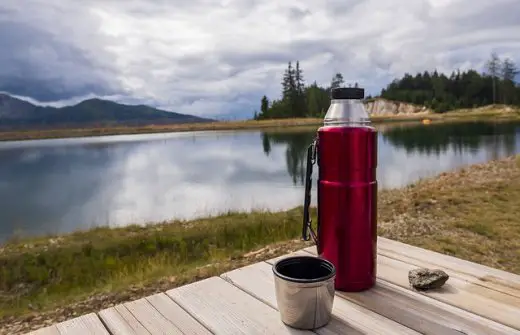
You can keep yourself warm at night by filling a water bottle with hot water and then sleeping with it. You can put it in your blankets or even better into the foot of your sleeping bag. The heat will get trapped inside and keep you warm all night.
If you have a camping stove with you, it will be easy to boil water with that.
If you do not have a camping stove, no need to worry, a pot and a fire are all you need. Just boil water over the fire and pour it into your water bottle before bed. It will keep you nice and toasty for hours.
Use The Hot Stone Trick
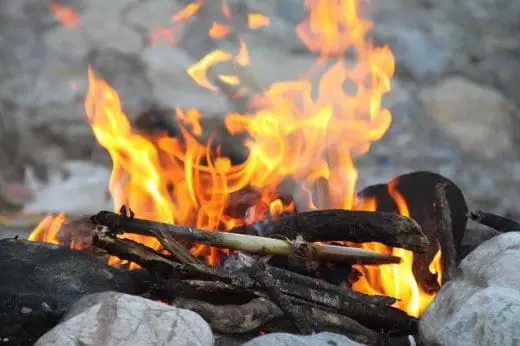
You can heat stones by the fire and then use them to keep yourself warm at night. If you use enough stones, you can get your tent really cooking.
This is how some Native American sweat lodges are heated. You want to pick the right stones for the job. You want them to be big enough to retain a good amount of heat but not too big that they are hard to carry.
Leave them by the fire for a while and let them absorb heat. Make sure you don’t let them get too hot, or you might not be able to pick them up. When you are ready to go to bed, bring them inside your tent, and they will make it nice and toasty.
Eat Butter Before Bed

This is an old camping trip that will help you stay warm at night.
Bring a stick of butter with you and eat some of it before bed each night. Something about the way that your body digests butter generates heat that will keep your body warm and get trapped in your sleeping bag or blankets.
I was skeptical the first time I tried it, but I woke up later that night sweating after eating a little butter before bed. It really works. Now I bring a stick of butter with me whenever I go camping and it’s cold at night.
This article is owned by Recapture Nature and was first published on February 14, 2020
Sleeping Aids

For some, it may be hard to sleep outside in the wild. If this describes you, don’t worry. You can bring earplugs or drink a sleepy time tea to help you drift away at night. If neither of these work there are over the counter sleeping aids that will definitely help you get some Zs.
Ear Plugs
When you’re going camping you never know what types of noises and sounds are going to be present at your campsite.
You might have noisy neighbors that want to stay up all night, or the wildlife might be making a racquet when you are trying to sleep. Bring some earplugs along with you so that you can drown out the noise and get a good night’s sleep.
Bedtime Tea
There are many different kinds of teas that contain calming herbs that will help you relax and fall asleep. Find your favorite one and bring it camping with you.
You can have a cup before bed to help you get ready to sleep. Not only will it calm you and help you sleep, but it will also warm you up before sleeping through the cold night.
This article is owned by Recapture Nature and was first published on February 14, 2020
Melatonin or Other Over the Counter Sleeping Aids
If the other tricks don’t work and you’re still finding yourself sleepless at night, try using an over the counter sleeping medication. Melatonin is my go-to. It is a naturally occurring hormone in the body and the stuff seriously works. If you don’t like melatonin, there are plenty of other over the counter sleeping aids such as Tylenol PM or Advil Pm.
Resources
- Calming Habits: The Difference Between 1,2,3,4 and 5 Season Tents
- Rei: How to Choose Sleeping Pads
- Amazon: Intex Pull Out Sofa
- Amazon: Large Reusable Ice Bag for Coolers
- Art of Manliness: How to Recognize Poison Ivy, Oak, and Sumac and Treat Their Rashes
- Rei: Food Storage and Handling for Campers and Backpackers
- US News: How to Protect Yourself Against the Threat of Ticks

